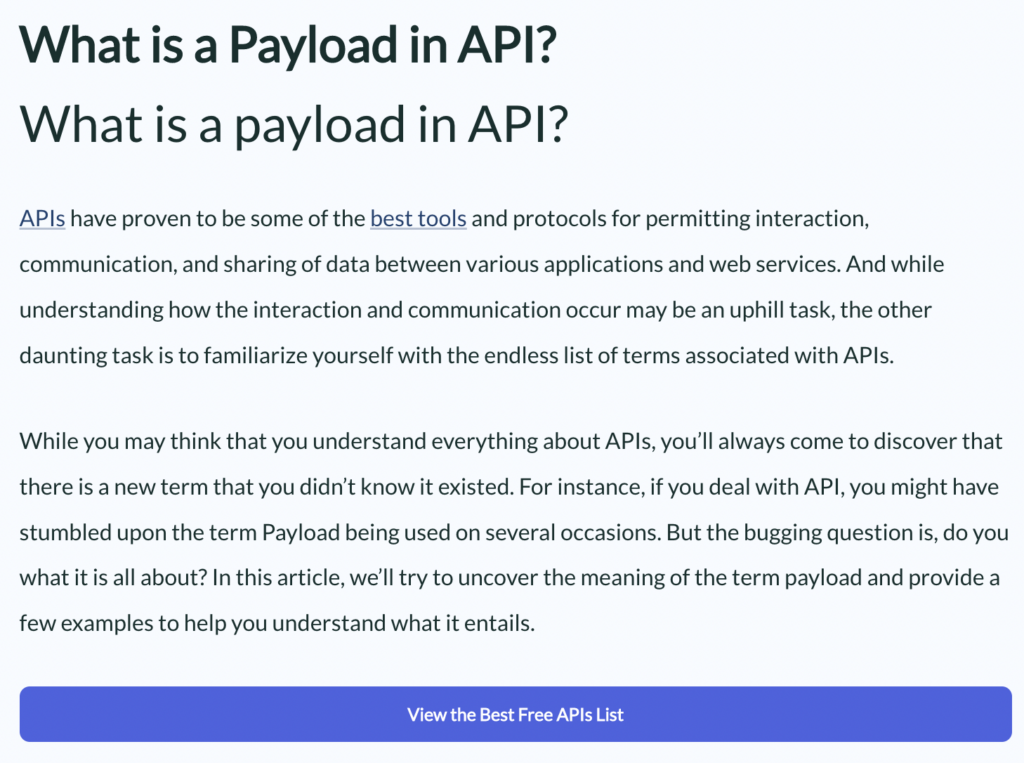You know content is key to reaching more of the right developers. But keeping up with a consistent cadence of blog posts, guides, and tutorials can be challenging, especially if you’re the only one writing.
This is where a team of developer content writers can come in handy. You might expand your existing marketing team, look at internal contributors, or work with outside writers. Any of these approaches can prove harder than it initially seems. And each has its drawbacks from your ideal content engine.
In this post, we’ll look at the most common paths of finding internal contributors, building a freelancer program, and using an external agency. In each case, you’ll improve your success if you enter into the collaboration with a solid developer content strategy.
Find Internal Blog Contributors
A stable of solid internal contributors can make a big impact on your content engine. Done well, you can consistently publish new articles and expand your evergreen back catalog. Plans don’t always match reality, as contributors balance shifting and competing priorities. A clear content strategy can focus your efforts to get the most from each contribution.
In my experience, dev-focused companies tend to look in a few common places for internal contributors:
- Marketing
- Engineering
- Developer relations
- Support or sales engineering
Content programs often originate within marketing, and writing is a core skill for a marketer (the Marketing Organization chapter of Developer Marketing Does Not Exist goes into detail here). It’s rarer to find a developer background in a marketer skill set. Sometimes this can be overcome with deep research into your audience, which may delay your marketing activities.
More often than not, technical content written without development experience will fall flat. It will come across as hand-wavy or promotional. Either of these is enough to send developers to someone else’s content for their answers—assuming they ever find yours in the first place.
Good technical content starts at the concept level, following your content strategy. It speaks to developer problems without presenting a silver bullet. Naturally, to get the developer tone right, you might look to your internal engineers, founders, and others who feel the developer problems your product solves.
These posts can attract your audience because they’re written from a similar perspective. They also can underperform if they aren’t in line with your content strategy. For example, obscure “inside baseball” posts might not draw enough developers with the specific problem described. Perhaps worse, you can attract a lot of attention, but the developer problem is not close enough to your product’s sweet spot.
Even if you find engineers to write, their management will always compare these efforts to writing code. And you already know which will get the higher priority. On multiple occasions, I checked in with internal engineers about their post status. “I should have time tonight or this weekend,” they’d say. That’s unsustainable.
Let’s say work time is prioritized for content. Now add a common affliction of engineering writers—the over-polishing of perfectionism—and you will struggle to keep the content flowing. In their typical work, engineers must find every edge case to deliver solid code. They’ll bring this same detail to their writing. That may seem like a good thing—until their manager finds out it took the greater part of a week to deliver a draft. That’s not an exaggeration. If you can’t show a big impact soon after publication, you’ll have a hard time courting additional contributors.
Developer relations is a natural content partner. You’ll find many of the skills needed to be successful: writing, coding, developer empathy, and the ability to work quickly. If you have a developer relations team, they are also pulled in many directions.
The good news is that developer relations has the raw ingredients of great content. Their code repos and demos can be converted to technical content, though they may need to be tweaked to fit your content strategy. Dev rel is often sharing your product with developers.
You want most content to focus on the problem, not the product. The best approach with dev rel blog contributions is to understand their team’s goals, then connect blog success to their metrics. Without this step, it will seem like yet another department pulling at an overworked team. Plus, as developers themselves, they might be predisposed to be skeptical of marketing. Show that your motives are aligned, because developer education will benefit the entire company.
Unsurprisingly, the same approach works with any internal audience. Without goal alignment, it will be difficult to create a sustainable contributor program. To reach more of the right developers with this content, you really must also ensure the topics align with your content strategy. When you’re begging for content contributions, it’s easy to let go of this requirement. Throwing non-strategic content against the wall will have minimal lasting impact. What to write becomes even more important when you look outside your organization for external contributors
Build a Freelance Contributor Team
Most companies look for outside contributors to scale their content programs. You can find a balance of technical background and communications skills in freelance writers. Compared to internal team members, they may have fewer scheduling conflicts (though you’re competing with their other clients for their time). Someone outside your company also has an external perspective that may be closer to the audience you want to reach.
With all these things in favor of an external contributor team, here are places you might look to find them:
- Developers in your community
- Freelance technical writers
- Gig workers on freelance sites
- Professional devs already writing
Of course, there are tradeoffs for each of these types of developer writers.
Developers in Your Community
Many teams prefer to find freelancers within their own community, who understand both the product and the problems it solves. In fact, companies like DigitalOcean and Linode have famously found great success with their contributor programs. It’s worth noting that the scopes of the programs are broad, with just about any development topic fair game.
Ideally, your program would be more focused in its early days. As with internal contributors, it’s important to understand your content strategy before scaling your publication. When you look outside your community, you’ll need to know what topics you’re looking to cover. Otherwise, you might receive product overviews, basic tutorials, and other contributions that lean too promotional.
Freelance Technical Writers
Freelancers can be a great way to start a contribution program without getting too formal from the start. Recruit existing freelance writers with a background or focus on technical topics. Specific post ideas will help find the right freelancers and show you’re clear on where you need their help. You shouldn’t expect a freelance writer to pitch strategic content—they don’t have enough context about your company and how it reaches developers.
One quick note on “technical writers,” or “tech writers.” These titles often have very specific meanings. Tech writers take complex ideas, suss out the details from experts, and turn the results into writing that is typically more like documentation. It’s an important role, but it’s rarely the type of content that will attract developers. In addition, tech writers don’t always have developer backgrounds, nor will they have experience with marketing content.
Gig Workers on Freelance Sites
Instead, look for someone with a developer background who also shows an interest in writing. These can be hard folks to find and you’ll be competing with their coding work. You can attempt to use Upwork, Fiverr, or similar freelance marketplaces. My experience, which has been corroborated by many others I trust, has been almost entirely negative. These sites can be useful when you need to find a very specific technical skill and writing is not the top criteria. Otherwise, it’s best to put your efforts elsewhere.
Professional Devs Already Writing
The most valuable freelance contributors for technical topics are waiting for you to discover them. They’re already writing and sharing their knowledge, even if they aren’t being paid for it. Read similar content to what you want to publish and you will discover them on Hashnode, Dev.to, Medium, or even their own blogs. Find them and invite them to write for your company on a freelance basis.
Regardless of how you discover the freelancers who contribute, you should expect a healthy editorial cycle. That’s because you’re looking for an overlap of skills that’s tough to find:
- Technical background
- Knowledge of your problem space
- Writing ability
Most commonly, you’ll find someone strong in one of these, maybe two. Even a fantastic writer who is strongly technical may not know enough about how your product—or the problems it solves—to contribute without significant edits. That’s one reason it might make sense to enter into longer engagements than you might with typical freelancers. One approach to both the editing and context issues is to work with an agency that can take on some of the burdens.
Hire an Agency for Help
Running a freelance contributor team can feel like a full-time job. Some dev-focused companies have multiple staff members to recruit, evaluate, coordinate, edit, and publish content from outside contributors.
It can be tempting to avoid the effort to build and maintain an external writing staff. An external agency can handle some or all of this administrative burden. You’ll find many types of agencies, but they most commonly fall into one of a few categories:
- General content marketing
- Industry specialists
- Technical specialists
Dev-focused companies will almost always be better off with specialists. There’s just too much to know about either your industry or the technology behind your product.
The typical general content marketing approach uses search engine optimization (SEO) almost exclusively. It is important to consider search terms because content has a much longer life if it receives evergreen traffic. However, with a developer audience, the focus on SEO will come through inauthentic content. The most frequent side effect of generic content marketing is keyword-stuffed nonsense.
Remember that you want to not only attract developers to your content, but you want them to resonate with what they read. That likely requires a technical background usually missing from a general content marketing agency.

For example, this may seem technical and accurate to the untrained eye. However, the headline isn’t written like a developer ( “in an API” is the simplest rewrite). The random links in the opening paragraph betray a strategy built around SEO, not developers. And never mind that it barely makes sense.
The general content marketing approach aims for volume. It may look successful in aggregate, but most individual pieces miss the mark with developers.
That leaves the specialty agencies, which are understandably rarer. In a perfect world, you’d have writers with a background in both industry and technology. Usually, you’ll need to choose one.
Industry background may be important to explain the context of year product. For example, if you have a fintech tool, you’ll need to help developers know what financial systems require. There are industry regulations, which differ by country. These may play a huge role in your product. In fact, your product may ease the pain of regulations—but you’ll need to share that benefit with developers without hand-waving over what makes it important.

When we worked with OpenCage on its reverse geocoding guide, we needed to go beyond the technical details. Their geocoding API is easy to use, but behind that interface is a specialized location and open data knowledge. We called upon extensive knowledge transfer from the OpenCage team, as well as our own geospatial background to deliver a deep, helpful guide for developers.
Most content an agency delivers will require some problem context. Often, the technical background of the writer is the more important element. You’ll look for tutorials and other educational content to explore the problem and solution without feeling like documentation.
It can be difficult to get consistent output from many freelancers, but an agency should be better at hitting this mark. Ideally, they’ll perform most editing before content is delivered. You’ll still want your own review, especially early in a relationship. Keep in mind the agency’s specialization and keep most of your review focused on the industry knowledge if they focus on the technical background (and vice-versa).
Most specialty content marketing agencies will perform better if you bring the content concepts to them. They can’t become experts in the strategy you want to employ. The better you’re able to explain what you need, the more likely you’ll get results. That allows the agency to focus on its subject expertise and editorial process.
Define a Strategy, Then Find Writers
Building a team of writers who are eager to put pen to paper (metaphorically, of course) may feel like the most pressing issue. But before you start searching for the best internal blog contributors, freelancers, or an agency, know this: the content produced is only as good as topics that resonate with developers.
You should first focus your energy on coming up with content concepts that your audience is looking for right now and develop your strategy. Only then can you feel confident that your investment in content and those who will write it is worth it.
If you need help figuring out the topics your target market is looking for, you can follow our proven process. Based on our work with some of the best dev-focused companies in the world (including Snowflake, Algolia, and Stoplight), our Technical Content Accelerator will give your future team the tools to identify the best developer content opportunities.
